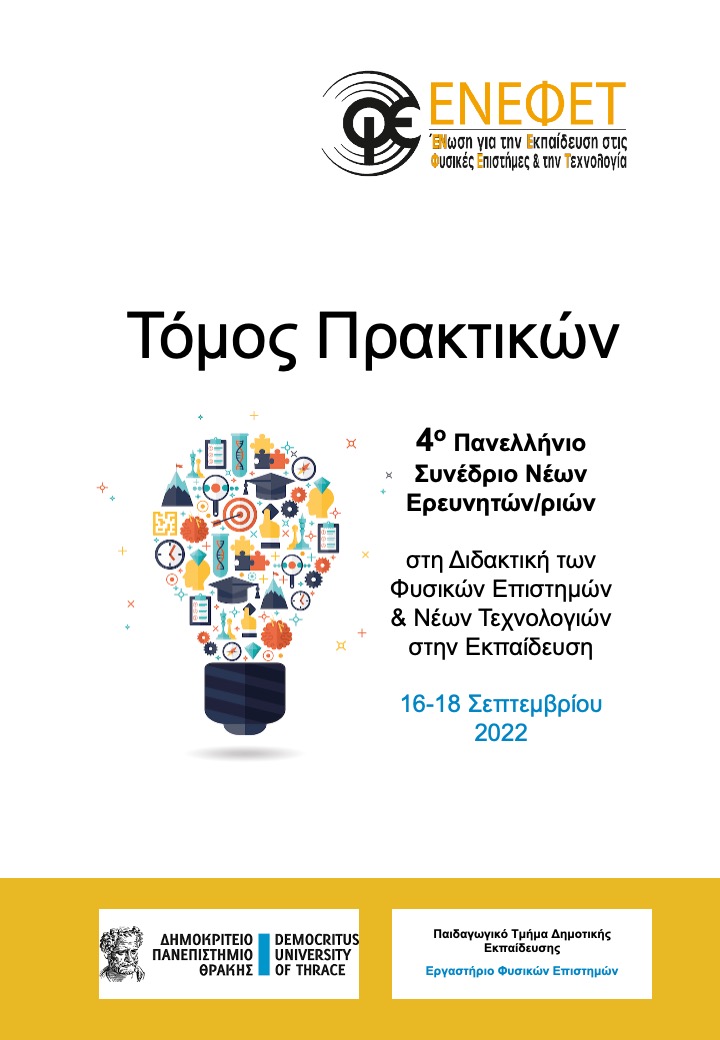Ιστορικά επιστημονικά όργανα στη μη-τυπική Εκπαίδευση: Οι απόψεις και ο ρόλος των εκπαιδευτικών

Published:
Sep 14, 2024
Keywords:
Historical scientific instruments non-formal education educators
Abstract
The benefits from the use of History of Science in education and its effectiveness for highlighting aspects of the Nature of Science is widely accepted by the teaching community. In this context a variety of possibilities becomes evident from the literature, concerning the utilization of historical scientific instruments for the preservation of the scientific heritage as well as the education of students and citizens in formal and non-formal teaching environments. In this paper a promotion of the educator’s role in the creation of educational material based on historical scientific instruments in the context of non-formal education is attempted.
Article Details
- Section
- ΜsCs
- Categories
References
Στεφανίδου, Κ., Λάζος, Τ., Σκορδούλης, Κ. (2021). Η προσέγγιση των φοιτητριών του ΠΤΔΕ/ΕΚΠΑ στην ανάδειξη ιστορικών επιστημονικών οργάνων της συλλογής του Μαρασλείου ή «Όταν ο Edison συνάντησε τον Wheatstone στο Μαράσλειο». Πρακτικά 12ου Πανελλήνιου Συνεδρίου Διδακτικής Φυσικών Επιστημών και Νέων Τεχνολογιών στην Εκπαίδευση (υπό δημοσίευση).
Bennett, J. (1995). Can science museums take history seriously?. Science as Culture 5(1), 124-137. https://doi.org/10.1080/09505439509526419
Gallito, A., A., et al. (2022). Exploring Historical Scientific Instruments by Using Mobile Media Devices. The Physics Teacher 60, 202-206. https://doi.org/10.1119/5.0032111
Gallito, A., A., et al. (2021). An approach to the Venturi effect by historical instruments. Physics education 56(2), 1-9. https://doi.org/10.1088/1361-6552/abc8fa
Gargano, M., Gasperini, A., Cirella, E.O., Smareglia, R., Zanini, V. (2016). The AstroBID: Preserving and Sharing the Italian Astronomical Heritage. In: Calvanese, D., De Nart, D., Tasso, C. (eds) Digital Libraries on the Move. IRCDL 2015. Communications in Computer and Information Science, vol 612. Springer, Cham, 71-74. ISBN: 978-3-319-41938-1.
Gay, L. R., Mills, G. E., and Airasian, P., 2017. Η εκπαιδευτική έρευνα. Αθήνα: Εκδόσεις Προπομπός. ISBN: 9786185036300
Gires, F. & Lauginie, P. (2013). Preserving the scientific and technical Heritage of Education: the ASEISTE. Museologia e Patrimonio 6 (1), 161-178.
Heering, P. (2015). Make–Keep–Use: Bringing Historical Instruments into the Classroom. Interchange 46, 5–18. https://doi.org/10.1007/s10780-015-9228-8
Lourenco, M., C. & Wilson, L. (2013). Scientific heritage: Reflections on its nature and new approaches to preservation, study and access. Studies in History and Philosophy of Science Part A 44 (4), 744-753. https://doi.org/10.1016/j.shps.2013.07.011
Paparou, F. (2011). ‘Shall we Stroll to the Museum?’: Educational Proposal for the Exploration of an Historic School Scientific Instrument Collection. Science & Culture: Promise, Challenge and Demand, Proceedings of the 11th International IHPST Conference, Edited by: Fanny Seroglou, Vassilis Koulountzos and Anastasios Siatras,Thessaloniki, Greece, 1-5 July 2011, 574–580.
Resnick, M., Berg, R. & Eisenberg, M. (2000). Beyond Black Boxes: Bringing Transparency and Aesthetics Back to Scientific Investigation. The Journal of the Learning Sciences 9(1), 7-30. https://doi.org/10.1207/s15327809jls0901_3
Riess, F., Heering, P. & Nawrath, D. (2006). Reconstructing Galileo's Inclined Plane Experiments for Teaching Purposes. Proceedings of the 8th International History, Philosophy, Sociology &Science Teaching Conference, Leeds, 1-10.
Soubiran, S. (2010). Is research and teaching a key for preserving university collections and museums?. University Museums and Collections Journal 3. 21-30. https://doi.org/10.18452/8676
Soubiran, S. (2008). What makes scientific communities think the preservation of their heritage is important?. University Museums and Collections Journal 1. 1-8. https://doi.org/10.18452/8627
Stefanidou, C. and Panagopoulou, M. (2019) Informal Science Education in the Footsteps of Galileo’s Dialogue. Advances in Historical Studies, 8, 175-191. https://doi.org/10.4236/ahs.2019.85013





